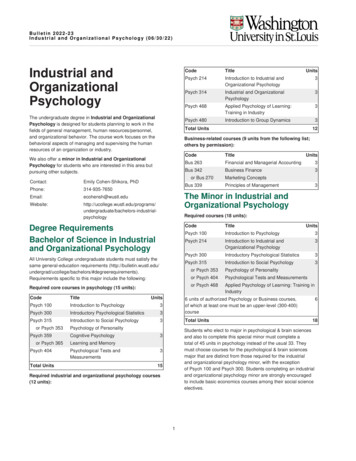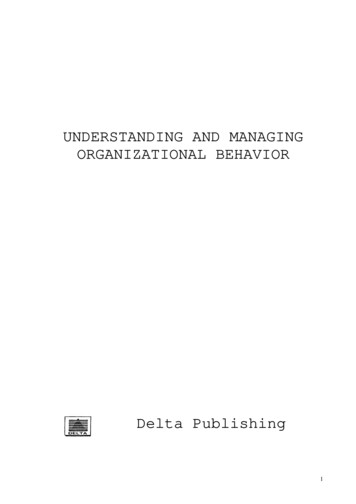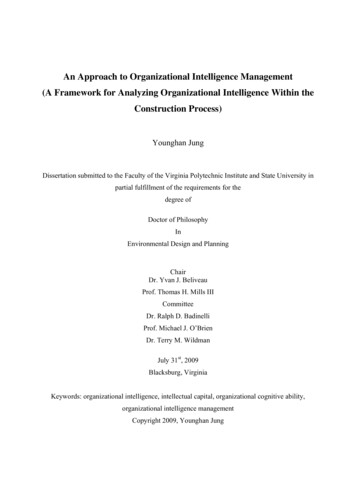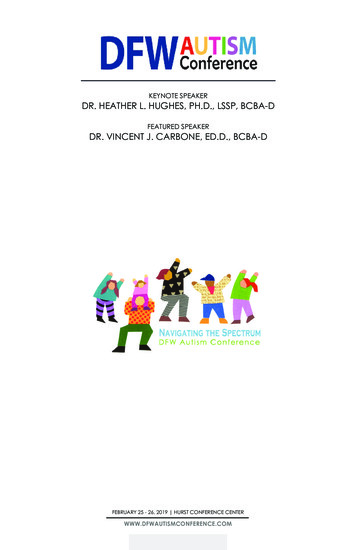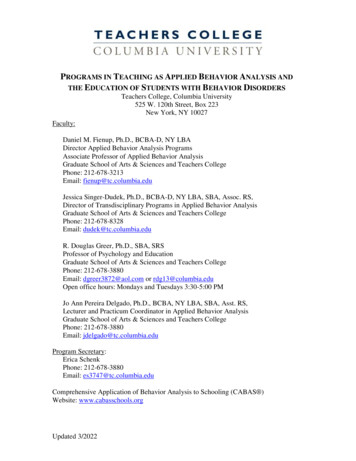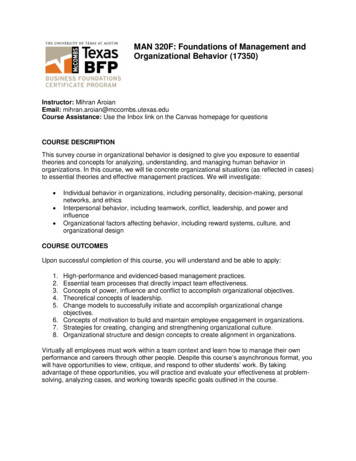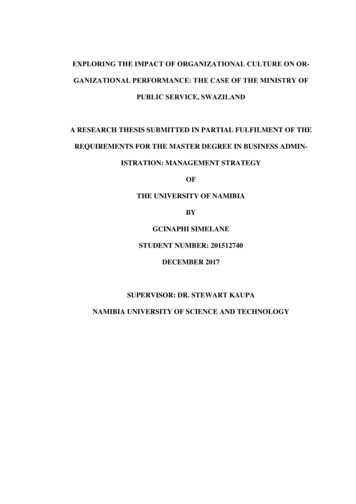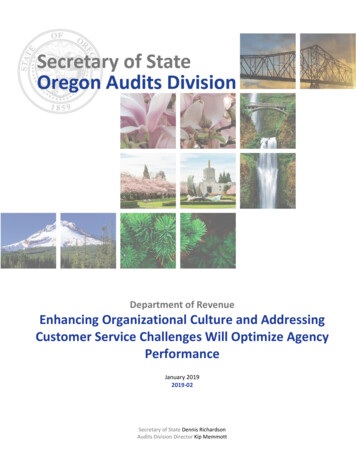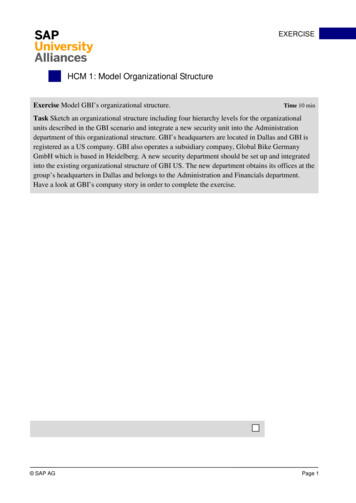
Transcription
1Management and Organizational BehaviorExhibit 1.1(leyla.a/ flickr/ Attribution 2.0 Generic (CC BY 2.0))IntroductionLearning OutcomesAfter reading this chapter, you should be able to answer these questions:1. What is the meaning of work in a societal context?2. How do recognize and meet the challenges facing managers in the new millennium?3. What is expected of a manager?4. What is the role of the behavioral sciences in management and organizations?EXPLORING MANAGERIAL CAREERSThe Management Challenge at Apple and GoogleWhen Apple was developing iOS 10, a group of 600 engineers was able to debug, develop, and deploythe new programming within two years. Contrarily, Microsoft engineers were able to develop andexecute the programming on Vista, but it took considerably longer and was a bigger undertaking, withalmost 6,000 engineers at hand. What was the difference?According to the study conducted by leadership consulting firm Bain & Company, companies like Apple,Google, and Netflix are 40 percent more productive than the average company. Some may think that thisis a product of the hiring pool; big companies generally attract a more talented group of recruits. Withunique benefits and prowess in the industry, this must be the case. Wrong. Google and Apple havefound a way to answer the most fundamental question in management: How do you balanceproductivity while maintaining employee satisfaction and commitment?
8Chapter 1 Management and Organizational BehaviorCompanies such as Google have approximately the same percentage of “star players” as othercompanies, but instead of spreading out the talent, they group them dynamically to achieve morethroughout the day. This grouping focuses on grouping key players in the most business-critical roles,and is the key to success for the overall company. You’ve heard the saying “You’re only as strong as yourweakest link,” and in the case of Apple, there were no weak links, making their productivity extremelyhigh overall. To make matters more complicated, the fast-paced workplace and technology changes,including the diversity of employees and the global marketplace, takes a considerable toll on employeeexpectations, as do the overall stresses of the business performance. Apple is just one example of acompany that figured out one of the pieces to this puzzle, but it is illustrative of what is happening in theworkplace all around the globe.Contemporary managers are witnessing changes in technologies, markets, competition, workforcedemographics, employee expectations, and ethical standards. At the heart of these changes is the issueof how to manage people effectively. To attain corporate objectives, each manager must discover how todevelop and maintain a workforce that can meet today’s needs while getting ready for tomorrow’schallenges. As a result, managers are asking questions such as:How can we meet the international competition?How can we make this organization more effective?How can we better utilize our human resources?How can we create a more satisfying and rewarding work environment for all employees?How can we improve the quality of our products?How can we improve communication and decision-making processes at work?How should we evaluate and reward performance?How can we develop the company leaders of tomorrow?Questions such as these point to the issue of effective management. That is, what can managers do toimprove both organizational and employee performance? Effective management requires an in-depthknowledge of financial management, marketing research and consumer behavior, accounting andcontrol practices, manufacturing and production techniques, and quantitative methods. In addition,however, effective management requires “people skills.” That is, a good manager must be able tomotivate his employees, to lead skillfully, to make appropriate and timely decisions, to communicateeffectively, to organize work, to deal with organizational politics, and to work to develop both employeesand the organization as a whole. These issues constitute the subject of this course. We shall examineprinciples of the behavioral sciences that can help managers improve both their own skills and abilitiesand those of their subordinates in order to enhance organizational performance and effectiveness.As a prelude to this analysis, we begin with a brief look at the natures of work and of management.Contemporary challenges are discussed. Next, we consider a model of organizational behavior that willserve as a guide throughout the study of management and organizational behavior. We begin with anexamination of work.1.1The Nature of Work1. What is the meaning of work in a societal context?This OpenStax book is available for free at http://cnx.org/content/col29124/1.5
Chapter 1 Management and Organizational Behavior9The Meaning of WorkWhat is work, and how do people feel about the work they do? These questions may be answered from severalperspectives. Perhaps one of the best ways to understand how people feel about their jobs is simply to askthem. A number of years ago Chicago writer Studs Terkel did exactly that. How did the people he interviewedfeel about their jobs? Here are some excerpts from his book Working.1I’m a dying breed. . . . A laborer. Strictly muscle work . . . pick it up, put it down, pick it up, put itdown . . . you can’t take pride any more. You remember when a guy could point to a house he built,how many logs he stacked. He built it and he was proud of it.—Steelworker [p. 1]I changed my opinion of receptionists because now I’m one. It wasn’t the dumb broad at the frontdesk who took telephone messages. She had to be something else because I thought I wassomething else. I was fine until there was a press party. We were having a fairly intelligentconversation. Then they asked me what I did. When I told them, they turned around to find otherpeople with name tags. I wasn’t worth bothering with. I wasn’t being rejected because of what Isaid or the way I talked, but simply because of my function.—Receptionist [p. 57]People ask me what I do, I say, “I drive a garbage truck for the city.” . . . I have nothing to beashamed of. I put in my eight hours. We make a pretty good salary. I feel I earn my money. . . . Mywife’s happy; this is the big thing. She doesn’t look down at me. I think that’s more important thanthe white-collar guy looking down at me.—Sanitation Truck Driver [p. 149]I’m human. I make mistakes like everybody else. If you want a robot, build machines. If you wanthuman beings, that’s what I am.—Policeman [p. 186]I usually say I’m an accountant. Most people think it’s somebody who sits there with a greeneyeshade and his sleeves rolled up with a garter, poring over books, adding things—with glasses. Isuppose a certified public accountant has status. It doesn’t mean much to me. Do I like the job ordon’t I? That’s important.—Accountant [p. 351]The boss . . . lost his secretary. She got promoted. So they told this old timekeeper she’s to be hissecretary-assistant. Oh, she’s in her glory. No more money or anything and she’s doing two jobs allday long. She’s rushin’ and runnin’ all the time, all day. She’s a nervous wreck. And when she askedhim to write her up for an award, he refused. That’s her reward for being so faithful, obedient.—Process Clerk [p. 461]Examples such as these—and there are many, many more—show how some employees view their jobs andthe work they perform. Obviously, some jobs are more meaningful than others, and some individuals are moreeasily satisfied than others. Some people live to work, while others simply work to live. In any case, peopleclearly have strong feelings about what they do on the job and about the people with whom they work. In our
10Chapter 1 Management and Organizational Behaviorstudy of behavior in organizations, we shall examine what people do, what causes them to do it, and how theyfeel about what they do. As a prelude to this analysis, however, we should first consider the basic unit ofanalysis in this study: work itself. What is work, and what functions does it serve in today’s society?Work has a variety of meanings in contemporary society. Often we think of work as paid employment—theexchange of services for money. Although this definition may suffice in a technical sense, it does notadequately describe why work is necessary. Perhaps work could be more meaningfully defined as an activitythat produces something of value for other people. This definition broadens the scope of work andemphasizes the social context in which the wage-effort bargain transpires. It clearly recognizes that work haspurpose—it is productive. Of course, this is not to say that work is necessarily interesting or rewarding orsatisfying. On the contrary, we know that many jobs are dull, repetitive, and stressful. Even so, the activitiesperformed do have utility for society at large. One of the challenges of management is to discover ways oftransforming necessary yet distasteful jobs into more meaningful situations that are more satisfying andrewarding for individuals and that still contribute to organizational productivity and effectiveness.Functions of WorkWe know why work activities are important from an organization’s viewpoint. Without work there is noproduct or service to provide. But why is work important to individuals? What functions does it serve?First, work serves a rather obvious economic function. In exchange for labor, individuals receive necessaryincome with which to support themselves and their families. But people work for many reasons beyond simpleeconomic necessity.Second, work also serves several social functions. The workplace provides opportunities for meeting newpeople and developing friendships. Many people spend more time at work with their co-workers than theyspend at home with their own families.Third, work also provides a source of social status in the community. One’s occupation is a clue to how one isregarded on the basis of standards of importance prescribed by the community. For instance, in the UnitedStates a corporate president is generally accorded greater status than a janitor in the same corporation. InChina, on the other hand, great status is ascribed to peasants and people from the working class, whereasmanagers are not so significantly differentiated from those they manage. In Japan, status is first a function ofthe company you work for and how well-known it is, and then the position you hold. It is important to notehere that the status associated with the work we perform often transcends the boundaries of ourorganization. A corporate president or a university president may have a great deal of status in the communityat large because of his position in the organization. Hence, the work we do can simultaneously represent asource of social differentiation and a source of social integration.Fourth, work can be an important source of identity and self-esteem and, for some, a means for selfactualization. It provides a sense of purpose for individuals and clarifies their value or contribution to society.As Freud noted long ago, “Work has a greater effect than any other technique of living in binding theindividual more closely to reality; in his work he is at least securely attached to a part of reality, the humancommunity.”2 Work contributes to self-esteem in at least two ways. First, it provides individuals with anopportunity to demonstrate competence or mastery over themselves and their environment. Individualsdiscover that they can actually do something. Second, work reassures individuals that they are carrying outactivities that produce something of value to others—that they have something significant to offer. Withoutthis, the individual feels that he has little to contribute and is thus of little value to society.We clearly can see that work serves several useful purposes from an individual’s standpoint. It provides aThis OpenStax book is available for free at http://cnx.org/content/col29124/1.5
Chapter 1 Management and Organizational Behavior11degree of economic self-sufficiency, social interchange, social status, self-esteem, and identity. Without this,individuals often experience sensations of powerlessness, meaninglessness, and normlessness—a conditioncalled alienation. In work, individuals have the possibility of finding some meaning in their day-to-dayactivities—if, of course, their work is sufficiently challenging. When employees are not involved in their jobsbecause the work is not challenging enough, they usually see no reason to apply themselves, which, of course,jeopardizes productivity and organizational effectiveness. This self-evident truth has given rise to a generalconcern among managers about declining productivity and work values. In fact, concern about this situationhas caused many managers to take a renewed interest in how the behavioral sciences can help them solvemany of the problems of people at work.CONCEPT CHECK1. Define work.2. What functions does work serve in modern society?1.2The Changing Workplace2. How do recognize and meet the challenges facing managers in the new millennium?It has often been said that the only constant in life is change, and nowhere is this truer than in the workplace.As one recent study concluded, “The United States is a competitive location to the extent that firms operatingin the U.S. are able to compete successfully in the global economy while supporting high and rising livingstandards for the average American. Although the U.S. retains profound competitive strengths—for instance,in higher education and entrepreneurship—those strengths are increasingly threatened by weaknesses inareas such as the tax code, basic education, macroeconomic policies, and regulation.”3 Companies face avariety of changes and challenges that will have a profound impact on organizational dynamics andperformance. In fact, in many ways these changes and challenges will determine who will survive and prosperinto the next century and who will not. Among these challenges are the following:The Challenge of International CompetitionUntil the 1980s, many American firms had little in the way of serious international competition. As a result,there was little incentive to innovate and remain efficient and competitive. Many companies became lazy andlost touch with their customers. This situation changed abruptly as companies in Asia and Western Europedeveloped more sophisticated products and marketing systems and gained significant market shares in homeelectronics, automobiles, medical equipment, telecommunications, and shipbuilding, to name a few areas. As aresult, American companies lost considerable clout—and profitability. In the 1990s and into the newmillennium, the lowering of trade barriers and acceptance of trade agreements like NAFTA led corporations toseek less expensive labor overseas. This led to lower costs and the ability to offer products at morecompetitive prices, but also led to a drop in manufacturing in industries like steel production, a drop inmanufacturing of products like iPhones, and the relocation of call centers from the U.S. to India.If we examine corporate behavior during the early decades of the new millennium, it is not difficult to see
12Chapter 1 Management and Organizational Behaviorsome of the reasons for the demise. In short, many North American firms lost their industrialcompetitiveness; that is, they lost their capacity to compete effectively in global markets, or they chose tolocate in foreign countries as a way to broaden their reach and become more competitive. Consider thefollowing examples:4During the last year reported, India experienced a 7.5 percent annual growth rate in real GDP while Chinarecorded an increase of 6.7 percent. This is a measure of how economies are progressing. Great Britain,France, and Italy all had close to 2 percent increases. At the same time, however, the United States recorded a3.8 percent annual increase (and Canada had a 3 percent increase), a larger increase after a lethargic recoveryfrom the 2009 financial crisis.While traditional jobs have shifted to developing countries, countries like the United States and Canada havetransformed their economies by incorporating more technology and automation as well as having a greaterproportion of the workforce in the service sectors. It is anticipated that the coming decades will continue tobring disruption to traditional workplace skills that will result in challenging workers to continually evolve theirskills.Finally, the number of products that were invented in the United States but are now primarily manufacturedoverseas has increased dramatically—advances in technology are helping the United States regain the top spotin world manufacturing. There had been a significant decline in our manufacturing sector as less expensivelabor in markets like India and China led companies to locate factories there. Since 2010, however, the UnitedStates has risen from fourth place to second and is expected to claim the spot as the leading nation by 2020.The major reasons for this are: advanced manufacturing capabilities require fewer “line workers,” and havingproducts produced near their major markets reduces transport and time to market.Considering several indicators of the relative competitiveness of economies using seven metrics, the U.S.performs quite well. The seven metrics are institutions, infrastructure, macroeconomic environment, healthand primary education, higher education and training, goods market efficiency, and labor market efficiency.When taking all of these factors into consideration (see Table 1.1), the United States ranks very well and hasan environment of stable growth. One challenge is that workers will need to be nimble and evolve as new skillsarise and will need to embrace continuous education and training as a way of managing their careers.Global Competitive IndexRankCountry/EconomyScoreDistance from Best1Switzerland5.90.00% from best2United States5.90.09% from best3Singapore5.72.60% from best4Netherlands5.73.34% from best5Germany5.73.46% from best6Hong Kong SAR5.55.56% from bestTable 1.1 (Attribution: Copyright Rice University, OpenStax, under CC BY-NC-SA 4.0 license)This OpenStax book is available for free at http://cnx.org/content/col29124/1.5
Chapter 1 Management and Organizational Behavior13Global Competitive IndexRankCountry/EconomyScoreDistance from Best7Sweden5.55.78% from best8United Kingdom5.55.99% from best9Japan5.56.19% from best10Finland5.56.29% from bestSource: Adapted from World Economic Forum, “Global Competitiveness series GCI, accessed July 19, 2018.Table 1.1 (Attribution: Copyright Rice University, OpenStax, under CC BY-NC-SA 4.0 license)In terms of organizational survival, herein lies what is perhaps management’s biggest challenge: how tobecome more competitive. Greater competitiveness requires an understanding of individuals, groups, andentire organizational systems. Throughout this course, we shall see numerous examples of how companiesfrom around the world are meeting the challenges of global competition. Particular emphasis will be placed onmanagement practices in other countries as a point of comparison.The Challenge of New TechnologiesAlthough it is common to think of “high tech” as applying only to the aerospace and telecommunicationsindustries, advanced technologies can be found throughout most industries. For example, most of us arefamiliar with the explosive growth in computing. Both hardware and software change so rapidly that it isdifficult for many companies to keep up. Personal computers are being replaced by cell phones that are nowfaster and more powerful than their predecessors. Cloud computing and access to big data and applicationstransform data into useful information that is increasingly complex and increasingly user friendly. InNovember of 1971 Intel launched the first microchip. Today, a modern Intel Skylake processor contains around1.75 billion transistors—half a million of them would fit on a single transistor from the 4004—and collectivelythey deliver about 400,000 times as much computing muscle. 5 More and more companies are using computerbased systems and equipment—such as e-mail, real-time messaging and file sharing, PDAs, and cellphones—for communications. As a result, the way in which employees and managers communicate and makedecisions is changing dramatically, and the importance of educated and knowledgeable workers is increasingrapidly.Technological changes also can be seen in the increased use of robotics, expert systems, and computerintegrated manufacturing systems, which have changed the way many products are manufactured today.Such changes affect not only production efficiency and product quality but also the nature of jobs. In manyindustries, the first-line supervisors are disappearing and being replaced by self-managing work teams whoassume responsibility for production scheduling, quality control, and even performance appraisals. All of thesetechnological changes require managers who are capable of effectively implementing technological change inthe workplace—managers who can adapt to the technological imperative while still maintaining and
14Chapter 1 Management and Organizational Behaviordeveloping the organization’s human resources. We will examine the role of technology as it relates toorganization structure, job design, communication, decision-making, and work-related stress. We will see howsome companies successfully adapted to technological change in a way that benefited all parties concerned.MANAGING CHANGESiri Struggles to Keep Up with the CompetitionMany executives struggle in the ongoing competitive landscape of technology. With fast-paced changes,staying one step ahead as well as being able to pivot quickly to respond to action are two criticalelements to successful leadership.Apple Inc. has made its third change in the past year to the leadership of the artificial intelligence voiceassistance system Siri. Due to many factors, including being outperformed by the competition such asGoogle Assistant and Amazon Inc.’s Alexa, the company decided to pivot and make the change.These two systems have seen incredible growth in 2018, with the Amazon Echo and Google Homeclaiming each 34 percent of the market. Now John Giannandrea, formerly Google’s head of search andAI, has joined the Apple team and is tasked with getting on the rival’s level from which he came (Verge2018).He will be challenged not only by having a new culture and company to fit into, but also by finding agood balance on how to innovate in his new role, as well as taking the best practices that he has from hisprevious role and applying it to boost the success of the Apple artificial intelligence. Keys to his successwill be how quickly he can adapt to the new role, learning, adapting, and making changes along the wayto bring Apple back to the playing field of artificial intelligence.Question 1: What other challenges would a new executive have coming from a competing company?Question 2: How much change is too much? What cautions should Apple be concerned about with all ofthe turnover for this position?Sources: Nick Statt, “Apple’s New AI Chief Now Oversees Siri, Core ML, and Machine Learning Teams,”The Verge, July 10, 2018, eams; Stephen Nellis, “Apple Shifts Responsibility For Siri to OperatingSystem Chief,” Reuters, September 1, 2017, m-chief-idUSKCN1BC65B; Tripp Mickle, Apple Hands SiriResponsibility to Executive Poached from Google,” The Wall Street Journal, July 10, 1531261759.The Challenge of Increased QualityThe challenge of industrial competitiveness incorporates several interrelated factors, including an appropriateproduct mix, manufacturing efficiency, effective cost controls, investment in research and development, andso forth. Not to be ignored in this pursuit is the quest for increased quality control of the products and servicesoffered in the marketplace. Total Quality Management (TQM) is a term often used to describe comprehensiveThis OpenStax book is available for free at http://cnx.org/content/col29124/1.5
Chapter 1 Management and Organizational Behavior15efforts to monitor and improve all aspects of quality within a firm. BMW established and continues to maintainits reputation in part because customers have come to respect its high level of quality. Quality is also a majorreason for the success of many Japanese products in North America. Simply put, if companies are going tocompete, renewed efforts must be devoted to enhanced quality assurance. This, too, is a managementchallenge. How can managers get employees to care about the products they produce or the services theyoffer? In this book, we will consider both the issue of quality control (what is it?) and mechanisms of ensuringimproved product quality (how do we get it?).Moreover, quality control includes several organizational issues. For instance, how can managers get partieswho are traditionally independently associated with a product to work together to build a better product? Thatis, how can they get the design staff, manufacturing engineers, workers, suppliers—and potentialcustomers—to come together and cooperate in developing and manufacturing a superior product? Later inthe book we will examine several instances in which such teamwork played a major role in qualityimprovement.The Challenge of Employee Motivation and CommitmentA major hurdle in the pursuit of industrial competitiveness is the traditional adversarial relationship betweenmanagement and workers. Whether a company is unionized or not, we see situations in which the averageemployee simply sees no reason to increase output or to improve the quality of existing outputs. Frequently,the company’s reward system restricts, rather than increases, performance. At other times, rewardsencourage employees to increase quantity at the expense of quality. Furthermore, North American companiesoften view their workforce as a variable expense (in contrast to Japan, where the workforce is viewed as a fixedexpense) and lay workers off when they are not needed for short-run activities. As a result, returning the favor,employees see little reason to be committed or loyal to their employers. Turnover and absenteeism rates areoften unreasonably high, further eroding performance efficiency and effectiveness.If companies are to succeed in an increasingly turbulent environment, managers must discover better ways todevelop and motivate employees. A company’s human resources often represent its biggest single asset, andfailing to properly nurture this asset leads to suboptimal return on an organization’s resources. Part of solvingthis problem involves knowing and understanding today’s employees. Exhibit 1.2 illustrates the variouscharacteristics employees consider important in their employers. Overall, employees seem to have a fairlypositive outlook on their employers. As illustrated in Exhibit 1.3, however, many millennials do not see theirtenure lasting for a long period and expect to have another job soon.
16Exhibit 1.2Chapter 1 Management and Organizational BehaviorHow Employees View Their Employers Source: Adapted from Deloitte, “2016 Deloitte Millennial Survey,” accessed July 18, vey-2016-exec-summary.pdf. (Attribution:Copyright Rice University, OpenStax, under CC BY-NC-SA 4.0 license)Exhibit 1.3Millennials and the Workplace Source: Adapted from Deloitte, “2016 Deloitte Millennial Survey,” accessed July 18, vey-2016-exec-summary.pdf. (Attribution:Copyright Rice University, OpenStax, under CC BY-NC-SA 4.0 license)This problem is made all the more difficult by the changing nature of occupations. As shown in Table 1.2, weare seeing a sharp increase in the number of technicians, service workers, and sales workers. Growth also canbe expected in engineering and managerial positions. These changes require a new look at how suchThis OpenStax book is available for free at http://cnx.org/content/col29124/1.5
Chapter 1 Management and Organizational Behavior17employees are motivated. For example, do we motive an engineer the same way we motivate a salesrepresentative? How do we motivate senior executives as opposed to junior managers? In this book, we shalltouch on these issues when we examine approaches to employee motivation. Managers have at their disposalseveral ways in which to increase employee motivation and performance, and an effective manager learnshow and when to use each approach.The Fastest-Growing OccupationsOccupationGrowth Rate 2016–20262017 Median PaySolar photovoltaic installers105% 39,490Wind turbine service technicians96% 53,580Home health aides47% 23,210Personal care aids39% 23,110Physician assistants37% 104,860Nurse practitioner36% 103,880Statistician34% 84,060Physical therapist assistant31% 57,440Software developers, applications31% 101,790Mathematicians30% 103,010Physical therapist aides29% 25,730Bicycle repairs29% 28,390Medical assistants29% 32,480Source: “Fastest Growing Occupations,” Occupational Outlook Handbook, Bureau of Labor .htm, accessed July 18, 2018.Table 1.2 (Attribution: Copyright Rice University, OpenStax, under CC BY-NC-SA 4.0 license)The Challenge of Managing a Diverse WorkforceHistorically, the American economy has been dominated by white males. They ha
The boss . . . lost his secretary. She got promoted. So they told this old timekeeper she's to be his secretary-assistant. Oh, she's in her glory. No more money or anything and she's doing two jobs all day long. She's rushin' and runnin' all the time, all day. She's a nervous wreck. And when she asked
